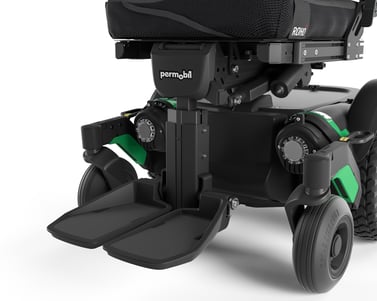Once you’ve worked out the best power wheelchair to suit the user’s needs, it’s time to select what type of legrests, or hangers, that the wheelchair will come with. It sounds like it should be an easy decision, but like most parts of a wheelchair there are several options and they each offer pros and cons.
The first thing to consider is whether you want swing away legrests or centre mount legrests.
Swing away legrests (pictured below) consists of two separate legrests that extend from each side of the seat. The legrests can be released, and each will swing away to the side. Swing away legrests are what we see most often on folding manual wheelchairs, so the design is usually familiar. The main benefit of swing away legrets is that when swung away, the area in front of the seat is left clear which allows a person to complete a standing transfer without worrying about the legrests being in the way. They can be easier for a user to swing away independently than centre mount legrests, as the release mechanism is located closer to the user and they usually don’t have to bend down too far. Another benefit is that as each legrest is separate from the other, you can individually adjust the angle of the legrest to suit a user’s needs.

Centre mount legrests (pictured below) extend from the centre of the seat. Centre mount legrests cannot swing away, but the footplates can be flipped backwards to move out of the way for transfers (however the centre post will remain). Centre mount footplates generally allow a power wheelchair to be more manoeuvrable, as the footplates are positioned closer into the midline of the wheelchair reducing the overall turning circle. They are often much stronger than swing away footplates, as the centre post is larger and cannot be bent as easily. If you have a user that damages footplates by running into objects, centre mount footplates are less likely to get damaged. However in this situation it is important to recognise that force from any impact has to go somewhere – if a wheelchair user does tend to run into walls regularly, as the centre mount footplates are less likely to bend when impacted, the force has to go somewhere and it might be the wall taking the brunt of the damage! Another benefit of centre mount footplates is visual. As the centre post is hidden behind the user’s legs, you see more of the user and less of the wheelchair. As many users prefer the wheelchair to be less visible with the focus on the person, this can be an important factor in choosing between legrest types.

The second thing to consider with choosing a legrest is whether you want elevating legrests or static/non-elevating legrests. Elevating legrests can be beneficial for users who require a change in knee angle for comfort, or to manage lower limb oedema or swelling (in conjunction with the tilt or recline mechanism). Elevating legrests are also recommended when the wheelchair will have a recline feature, for if a wheelchair backrest is reclined without the legs elevated at the same time it can place a lot of strain on the hamstrings and usually end up increasing pressures on the ischial tuberosities which we generally want to avoid.
Elevating legrests can be either powered or manual. With manual elevating legrests, the legrests can manually be moved up and down. It is rare for a user to be able to independently operate manual elevating legrests due to the location of the manual elevating mechanism and the force needed to lift the legrests up. Power elevating legrests consist of a powered actuator on the legrests, allowing the user to elevate or lower the legrests independently through their wheelchair controller. Some power wheelchairs also have the ability to have power extending legrests, where the legrest length can be moved up and down, essentially raising and lowering the height of the footplates, however this is a feature most associated with standing wheelchairs.
Both swing away legrests and centre mount legrests are available with elevation, however when using powered elevating legrests an important benefit is offered by centre mount legrests. On centre mount power elevating legrests, the actuator is located either under the seat or behind the centre post, shielding it from impacts. On swing away power elevating legrests, each legrest will have an actuator attached, usually to the legrest itself. Because the actuator sits on the legrest and outside of the wheelchair where it is most likely to be unintentionally knocked, the actuator is very prone to damage on swing away legrests. It can be an expensive part to fix or replace, so often centre mount power elevating legrests are used more frequently to reduce the risk of the actuators being damaged.
Your GTK consultant can help determine what type of legrest would best suit your clients. Contact us today to learn more or to organise a trial.



